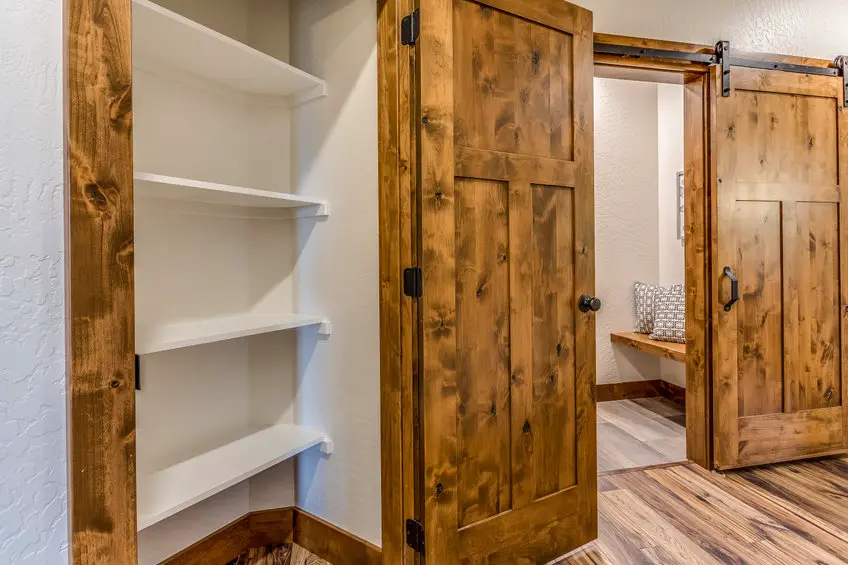Building a hallway linen closet can be an excellent solution that transforms an open wall into a functional storage space. Especially when it comes to apartments or smaller houses, utilizing the extra space that a hallway offers can help you organize your essentials and get rid of the clutter. Luckily, building a linen closet is a pretty straightforward process that requires you to follow a few simple steps.
Here’s how to build a linen closet in a hallway:
- Look for any unused wall space in your hallway.
- Gather materials.
- Mark desired dimensions onto the floor and walls.
- Cut the wood panels.
- Assemble the wood panels.
- Add baseboard trim and face frame.
- Hang the closet door.
- Finish and paint the drywall.
- Install shelves.
In this article, I’ll further explain how to go through each of these steps in order to build a beautiful and functional linen closet in your hallway.

1. Look for Any Unused Wall Space in Your Hallway
This first step revolves around finding the ideal space in which to install your closet.
Many people make the mistake of skipping through this step, as they think that any open space will do. In fact, there are several factors you need to consider when choosing the right empty wall for your closet.
First of all, you should think about the closet’s volume, because when your project turns three-dimensional, it’ll take up a lot more room than just the wall behind it. Make sure that the positioning doesn’t interrupt movement flow in your hall and doesn’t block the range of sight.
Furthermore, if you really want to make the most out of a tight space, you may want to consider merging the closet with unused space inside one of the rooms. This makes it a more complex and costly job, but for those who want to make the most out of every inch of space in their house, you might want to look into this option.
2. Gather Materials
After finding the perfect spot for your project, it’s time to start getting ready for the upcoming work.
For the process to go smoothly, you need to be prepared, gather all your materials, and keep them at a close distance so as not to run around frantically later in the middle of your work, looking for your wood glue or hammer drill.
The materials you’ll need depend on the type of closet you want to build, your skill level, budget, or other factors.
One thing you’ll always have to decide about, though, is the wood type that you’ll use. Most articles and forums advise on using plywood for your design. That said, depending on your personal preference and previous experiences, you can go for oak, pine, cherry wood, or other types of great wood choices.
for your design. That said, depending on your personal preference and previous experiences, you can go for oak, pine, cherry wood, or other types of great wood choices.
After choosing your desired material, you may opt to buy pre-made boards, or if you want to customize your panels, choosing a miter saw that you feel comfortable with would be crucial.
After making these major decisions, it’s time to gather the rest of your materials, such as wood glue, a good-quality hammer drill, driver, sandpaper, a nail gun, and any other additional tools that you think may come in handy during the building process.
3. Mark Desired Dimensions Onto the Floor and Walls
After you’ve gathered everything you think you’ll need, it’s time to mark the desired dimensions onto your floor and walls. This will give you a better idea of how the closet will fit within your hallway and will allow you to make last-minute adjustments that may end up saving you a lot of time and effort.
So although it may seem like an unnecessary step, it’s essential to visualize the end product before fully committing to building your closet.
Choosing these dimensions in this step will also be necessary if you’re thinking of buying pre-made sections of your closet, such as the wood panels or the door. So before committing, make sure you’ve done your measurements correctly.
4. Cut the Wood Panels
It’s finally time to start the building process. If you’ve already bought the panels in your desired dimensions, then skip to the next step.
If not, begin by firstly cutting the two side panels, along with the back of the closet. Afterward, start cutting the top and bottom panels as well. You may even start to work on your shelves at this point and set them aside.
They’ll be installed later on, but having them already cut and ready to use can make the process that much simpler.
Start by gluing together the side panels using the wood adhesive mentioned in the previous section. Add the top and bottom pieces, and finally the back, and wait for the glue to dry in order for the piece to be ready for final assembly.
Be careful handling the materials during this step, though, as the connection between panels is still fragile. The closet carcass may lose some structural integrity if handled without care.
5. Assemble the Wood Panels
After the wood adhesive has dried, you can start the final assembly process by firstly sanding down the edges to smooth out any rough surfaces and imperfections. After filing the panels, you can start putting them together by pre-drilling them first with your hammer drill, and then screwing them together using a driver.
At this point, the general structure should be stable, and after this process, your closet should be assembled and ready to be transformed through the last few touches into a polished piece of furniture.
6. Add Baseboard Trim and Face Frame
At this point, it’s time to add a baseboard trim, which will instantly transform the look of your project and bring it closer to its final shape.
Afterward, you can add a face frame and attach it the same way you assembled the panels themselves. You can leave the closet frame as is, or you can choose to add molding, which can really elevate its aesthetic.
Although adding molding is a mostly optional step, I advise at least trying it out, as it may help not only in producing a more aesthetically-pleasing piece but may also help in keeping the furniture’s balance better in the long run.
7. Hang the Closet Door
Now that the closet has reached its almost final shape, you can start to think about installing a door. Again, there are two possible options when it comes to choosing a closet door. The easiest solution would be installing a pre-made option with the correct dimensions for your closet size.
If you want to build your closet door as well as customize it to your taste, you can check out this video, which can help you in building your ideal closet door:
Although choosing this route may take a lot of time and effort, it’s the best way to get the perfect end product that’s tailored to your personal taste.
Installing the door, on the other hand, is a way more straightforward process. All you need to do is attach four butt hinges along your door and add the latter to your closet by placing it on the panel’s header plate.
8. Finish and Paint the Drywall
You can now add the last touches by finishing the drywall with a joint compound.
You can add it as needed to level the surface of your panels, and then let it dry. After the joint compound is dry, you can sand it down to remove any rough edges and give your closet a smooth finish.
After the base is all set, you can now paint the closet your desired color or add any decorations and designs that’ll make it match your hallway better. This is the step in which you can display your creativity and really make this piece of furniture your own.
9. Install Shelves
It’s finally time for the last step.
The closet is looking great by now, but in order to make it functional, you need to install the shelves that you set aside earlier. You can choose the ideal number of shelves for your closet and start the installation process by screwing them into the closet’s panels.
Although this is a traditional approach, there’s a wide variety of shelves you can choose from, including adjustable, sliding, or other items, so make sure to look into which type would work best for you.
After installing the shelves, your hallway linen closet is done, and you can transform this former empty space into a functional and aesthetically pleasing storage space.
Conclusion
Building a linen closet in your hallway is a process that can help you immensely in organizing your home.
Taking on the project of building a linen closet yourself is not as complex as it may seem. By following nine simple steps, you can transform your home by utilizing an empty wall to create extra storage space in your home.
You can make the process as involved or as straightforward as your budget and skillset allow, but at the end of the day, building a hallway linen closet is an excellent investment to make, especially for smaller homes.

